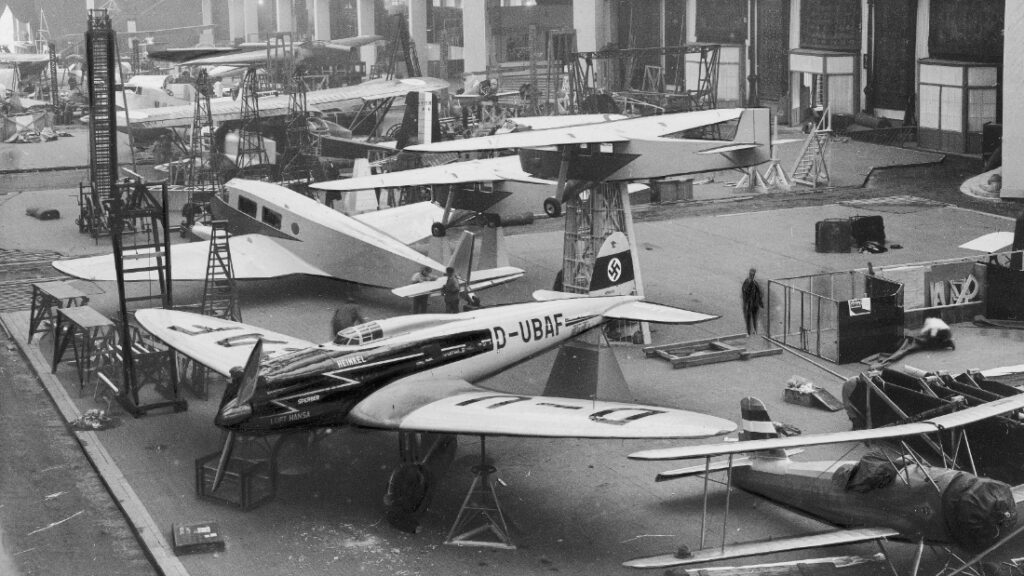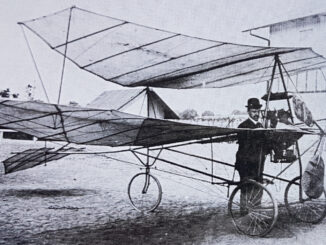 On 1st December 1932, a German mail and passenger aircraft Heinkel He 70, performed its maiden flight.
On 1st December 1932, a German mail and passenger aircraft Heinkel He 70, performed its maiden flight.
The Heinkel He 70 was one of representatives of the new generation of German aircraft, designed and developed in the early 1930s. Aeroplanes such as He 64 and He 70, Klemm Kl 32 and Kl 36, Messerschmitt Bf 108, Fieseler Fi 97 or Junkers Ju 60, were a clear message that the German aviation industry already recovered from prohibitions and bans imposed after the Great War, and is now ready to manufacture modern, all-metal, fast monoplanes that could be a base for future military aircraft.
The new German aeroplanes were built within Schnellbomber (English: fast bomber) initiative, based on theories developed by an Italian general Giulio Douhet. He believed that fast bomber aircraft would always break through the enemy defence, outrunning fighter aeroplanes and avoiding anti-aircraft fire.
Many of the German military authorities and politics were supporting that theory, including Adolf Hitler himself. He moved even one step further, claiming that medium bombers would be enough to bring all enemies to fall on their knees, despite short range and low payload. Speed had to be the key factor, hence the term Schnellbomber. As a consequence, Hitler decided to halt German development efforts on strategic bombers, and to focus on fast medium bombers instead.
Nevertheless, before the German aviation industry made its first real Schnellbomber, it had to learn how to build modern aircraft. In addition, that had to be done without arousing any suspicions from the Allied countries. Rapid development of sport and passenger aeroplanes was one of the ways – although officially introduced as civilian aircraft, many of them could be easily converted into combat variants or used for other military purposes.
The Heinkel He 70 was the first successful post-war design of Ernest Heinkel´s aviation company he founded in 1922. The key impulse for development of that aircraft was the requirement of the Deutsche Lufthansa company to create an aeroplane similar in performance to Lockheed Model 9 Orion, able to provide fast mail and passenger service on short routes.
Heinkel proposed a low-wing, cantilever monoplane, powered by a single, nose-mounted BMW Hornet engine, generating 575 hp. It was preapproved by Lufthansa and targeted at further development. In the early 1932, modernized variant of that design was ready. It was aerodynamically improved, equipped with new, elliptical wings and powered by BMW VI V-12 engine of 630 hp.

The aeroplane, officially designated He 70 Blitz (English: lightning), performed its maiden flight on 1st December 1932. During the test flights Blitz proved its excellent performance and shortly after was approved for serial production. Within only one year, the He 70 set eight world speed records, achieving the maximum speed of 377 and 357 kph (with 500 and 1,000 kg of payload, respectively).
At that time, the performance of the He 70 exceeded the maximum speed of then known fighter aeroplanes. Therefore, it did not take too long to develop a military variant of the aircraft. They were introduced to operational service in 1934, in two versions – the He 70E light bomber and the He 70F liaison and reconnaissance aircraft. In this way, the He 70 became the first embodiment of Schnellbomber idea.
There were approximately 300 examples of the He 70 built until 1937, when the production was ceased. The civilian variant of the aircraft was widely used by Deutsche Lufthansa on domestic routes and also on flights to Seville, Spain. In addition, Swissair acquired a few examples for express, trans-alpine flights.
Military variants were initially used only by the Luftwaffe. However, in 1937 eighteen examples were sold to Hungary and six to Spain. The Hungarian variant was equipped with Gnome-Rhône Mistral Major radial engine and later was re-designated He 170. One example of Blitz was sent for testing purposes to the Great Britain and another one to Imperial Japanese Navy Air Service. In the early 1938, all the He 70 from Lufthansa inventory were transferred to Luftwaffe.
The He 70 was for the first time used in combat during the Spanish Civil War – twenty-eight (or thirty, according to some sources) aircraft were sent there for Legion Condor there and then used for reconnaissance purposes. Eleven examples were then transferred to the Spanish Air Force, where they served until 1953.
With the appearance of He 111, the new Heinkel´s bomber aircraft, remaining examples of the He 70 in the Luftwaffe service were transferred to training units or used as liaison aircraft. The aeroplanes in Hungarian service were being used operationally until 1942.
The He 70, despite being the first successful development of the Heinkel company, had some impact on various future aircraft designs. Starting from its direct successor, the He 111, that copied many elements from the He 70 and was commonly nicknamed Doppel-Blitz (English: double lightning), then Aichi D3A Type 99 Carrier Bomber (Allied reporting name ´Val´) and even Supermarine Spitfire.

Cover photo: Heinkel He 70 D-UBYL, San Diego Air and Space Museum Archive, 01_00081271, Flickr Commons



